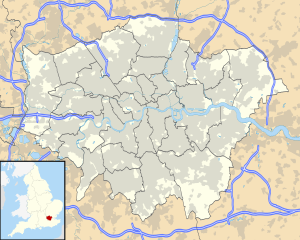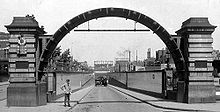Rotherhithe tunnel
| Rotherhithe tunnel | ||
|---|---|---|
|
Site plan and longitudinal section (1906)
|
||
| use | Road traffic | |
| traffic connection | A101 Limehouse - Rotherhithe | |
| place | London | |
| length | 1481 m | |
| vehicles per day | 34,000 (2005) | |
| Number of tubes | 1 | |
| construction | ||
| start of building | 1906 | |
| completion | June 12, 1908 | |
| business | ||
| release | June 12, 1908 | |
| location | ||
|
|
||
| Coordinates | ||
| Northeast Portal | 51 ° 30 ′ 39 ″ N , 0 ° 2 ′ 31 ″ W. | |
| Southwest portal | 51 ° 30 ′ 3 ″ N , 0 ° 3 ′ 6 ″ W. | |
The Rotherhithe Tunnel [ ˈrɒðəhaɪð ] is a tunnel in London . It is 1481 m long, crosses under the Thames and connects the districts of Limehouse and Rotherhithe . The tunnel is used for road traffic and forms part of the main A101 road. It was opened in 1908 by the then Prince of Wales, later King George V.
construction
The tunnel was designed by Maurice Fitzmaurice, chief engineer at London County Council . He decided to build it in 1900 with the passage of a law, the Thames Tunnel (Rotherhithe and Ratcliff) Act , despite considerable opposition from local residents. Around 3000 people had to be relocated because of the construction work.
Construction began in 1904. It was carried out by engineer Edward H. Tabor and the Price and Reeves company, and the cost was around £ 1 million. The tunnel was created partly through shield driving and partly through open construction. Today's entrance arches are the edge of the drilling shield of the tunnel boring machine used at the time , which had a diameter of 9.35 meters and thus specified the clearance profile .
Features of the tunnel
The Rotherhithe tunnel consists of a 1481 m long tunnel tube with a two-lane road. The maximum depth below the surface of the earth is 23 m. Four shafts were built to facilitate the construction work and to serve for ventilation. The two shafts directly on the river bank were given a spiral staircase to give pedestrians access. Both are now closed and the only pedestrian access is at the two tunnel portals.
Vehicles reach the tunnel via ramps that are open at the top and the walls are clad with bricks. After the tunnel portals there is a short section that was built using the cut-and-cover method. The drilled tunnel part between shafts 1 and 4 measures 1125 m and is clad with cast iron segments. During the tunnel construction it was said that the Rotherhithe tunnel was "the longest existing tunnel under a body of water".
The Rotherhithe Tunnel was originally planned to accommodate pedestrian and horse-drawn carriage traffic between the docks on either side of the river. Because of this, it has some special features. The street is relatively narrow, the two lanes are only 2.4 m wide, the sidewalks on both sides between 1.20 m and 1.80 m. The slope of the tunnel ramps is only 2.8% in order to cope with non-motorized traffic. There are relatively tight curves at the points where the tunnel goes under the river. This was to prevent the horses from seeing the light of day at the other end too early and therefore possibly going through.
On the other hand, this route, which is adapted to the needs of horse-drawn carriages, hinders motorized vehicle traffic today. Large vehicles cannot easily pass the tight curves and are therefore not allowed to use the tunnel. There is a speed limit of 20 mph (32 km / h) which is continuously monitored by cameras. A study in 2003 classified the Rotherhithe tunnel as the tenth most dangerous tunnel in Europe due to the inadequate safety measures. Since the portals are close to the river bank, the tunnel is at risk of flooding. For example, it was completely flooded during the floods in January 1928.
use
Like the other tunnels and bridges in London, the Rotherhithe tunnel now handles far more traffic than was foreseen in the planning. Shortly after the opening, 2,600 vehicles drove it every day. In 1955 the frequency was 10,500 vehicles per day, in 2005 over 34,000. Long traffic jams form in the vicinity of the tunnel portals, especially during rush hour.
Cyclists are allowed to use the tunnel, but this is considered dangerous due to the exhaust gases and the heavy traffic. Alternatives are Tower Bridge in the west or the Greenwich pedestrian tunnel in the east. Pedestrians can also use the tunnel, but only around 20 use it per day. Another way to get to the other side of the river in this area is the East London Line . The Rotherhithe train station is located directly at the southern tunnel portal; the closest train station on the north side is Wapping .
Web links
Individual evidence
- ^ "Rotherhithe Tunnel Jubilee", PLA Monthly , Port of London 1955
- ^ Rolt Hammond, Civil Engineering Plant and Methods , p. 150. (Benn, 1952)
- ↑ Denis Smith, London and the Thames Valley , p. 17. (Thomas Telford, 2000)
- ^ Henry Jephson, The Making of Modern London: progress & reaction: twenty-one years of the London County council , p. 62. (The London Liberal Federation, 1910)
- ↑ " UK's 'dangerous' road tunnels ", BBC News Online, April 24, 2003
- ^ "The South Side. Damage In Tooleystreet Area." The Times , January 9, 1928
- ↑ a b Rotherhithe Tunnel to close on Tuesday nights ( Memento of March 13, 2008 in the Internet Archive ), Transport for London, May 5, 2005
|
upstream Thames Tunnel |
River crossings of the Thames |
downstream Canary Wharf – Rotherhithe |



